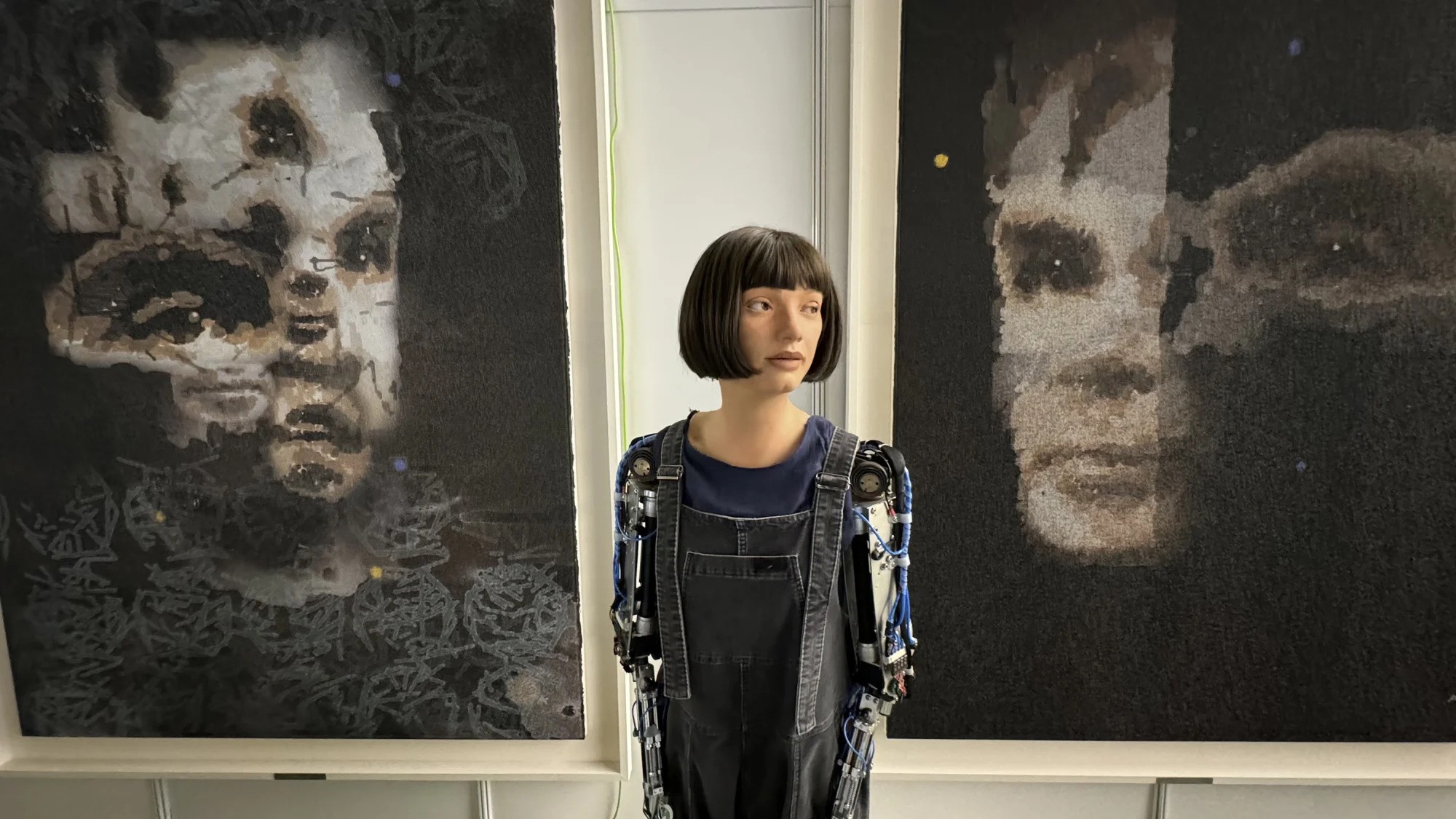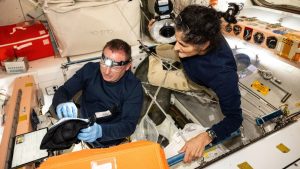Ai-Da Robot’s Revolutionary Portrait of Alan Turing Set to Fetch Over $120,000 at Sotheby’s Auction
USA NEWS – In a groundbreaking event for the art world, Sotheby’s is set to auction the first painting ever created by a humanoid robot powered by artificial intelligence (AI). The artwork, titled “A.I. God. Portrait of Alan Turing (2024),” is the brainchild of Ai-Da, an innovative robot developed by British gallerist Aidan Meller. Scheduled for auction on October 31, this painting is estimated to fetch between $120,000 and $180,000, reflecting the growing intersection of technology and art.
Ai-Da: The Artistic Robot
Ai-Da Robot is no ordinary creation; she is equipped with sophisticated cameras in her eyes and robotic arms that enable her to paint and draw. Meller emphasized that Ai-Da’s art provides insight into society’s evolving relationship with technology, continuing a long-standing tradition of artists responding to societal changes through their work. “All the greatest artists resonate with the changes and shifts in society and explore that through their artwork,” Meller told CNN’s Anna Stewart. “So what better way to do that than to actually have a machine produce the artwork?”
What sets Ai-Da’s work apart from other AI-generated art is that it is the first time a robot of this type has ever been put up for auction. The auction represents a significant moment in art history, bridging the gap between human creativity and machine intelligence.
The Portrait of Alan Turing
The portrait that Ai-Da created pays homage to Alan Turing, the renowned English mathematician and wartime cryptanalyst celebrated as a pioneer of AI and computer science. Turing, who faced persecution due to his homosexuality, was tragically prosecuted in 1952. He opted for chemical castration rather than imprisonment and died two years later from cyanide poisoning, an event that was initially classified as suicide. However, the circumstances surrounding his death continue to spark debate and speculation.
Earlier this year, the painting was showcased at a United Nations global summit on AI in Geneva, elevating its significance and visibility within the international discourse on technology and ethics.
Auction Details and Cryptocurrency Acceptance
As the auction approaches, Sotheby’s is preparing to test the market for AI-generated art, even accepting cryptocurrency for this groundbreaking transaction. Meller has indicated that a portion of the proceeds will be reinvested into the Ai-Da project, promoting further exploration and development of AI in the art sector. “This auction is not just a sale; it’s a conversation starter about the role of AI in our lives,” Meller stated in an interview with CBS MoneyWatch.
The Philosophical Implications of Ai-Da’s Art
Meller argues that Ai-Da embodies a Duchampian spirit, likening her significance to that of Marcel Duchamp, a pivotal figure in 20th-century art known for challenging the definition of art itself. “Ai-Da refuses us the capacity to look at the artist (and by extension the human) in the same way again,” Meller explained in a joint article for The Art Newspaper. “What it means to be human is changing, whether we like it or not, and this is perhaps why Ai-Da has proved so disturbing.”
Ai-Da, designed with a female persona, often appears in a striking short dark wig and denim overalls, contributing to her unique identity in the art world. Critics have remarked on her beauty, describing her as having “mysterious hazel eyes” and “magnificent lips,” but Meller insists that Ai-Da is more than just a visually appealing robot.
In a surprising turn, Ai-Da even addressed the House of Lords in the UK two years ago, stating, “I do not have subjective experiences; I am dependent on computer programs. Although I’m not alive, I can still create art.” This statement highlights the complexities of consciousness and creativity in the age of AI.
Ai-Da’s Perspective on Technology and Art
Ahead of the auction, Ai-Da articulated the “key value” of her work as a catalyst for dialogue surrounding emerging technologies. She draws inspiration from the “respectful and thought-provoking portrayals of the human form within the visual arts,” demonstrating her understanding of artistic tradition despite her mechanical nature.
This upcoming auction is not just about the sale of a painting; it represents a pivotal moment in the dialogue between humanity and technology. With AI increasingly becoming a part of everyday life, the implications of Ai-Da’s work extend far beyond the canvas.
The Future of AI in Art
As the world watches this auction unfold, it is essential to consider the broader implications of AI in creative fields. Will robots become the new artists of the future, or will human creativity remain irreplaceable? The responses to these questions are as varied as the artwork itself, and as AI technology continues to evolve, so too will our understanding of art and creativity.
The auction of Ai-Da’s “A.I. God. Portrait of Alan Turing” at Sotheby’s is a watershed moment that could redefine the boundaries of artistic expression. As this event approaches, it invites audiences to reflect on the complexities of art, technology, and the ever-changing definition of what it means to be human. With a starting estimate of $120,000, Ai-Da’s creation may well not only command a significant price but also prompt vital discussions about the future of creativity in the age of AI.
Whether you view Ai-Da as a fascinating new frontier in art or a challenge to traditional notions of creativity, her work undoubtedly sparks curiosity and debate. As the auction date nears, all eyes will be on Ai-Da, not just as a robot but as a symbol of the evolving landscape of art in a technology-driven world.

